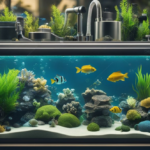Bird feeding is an enjoyable outdoor activity that offers a great way to connect with nature. It is a hobby that has been around for centuries and has evolved over the years with the introduction of new bird feeding accessories. Bird feeding accessories are essential tools that help to enhance the bird feeding experience by making it easier, more convenient, and more enjoyable for both the birds and the bird watchers.
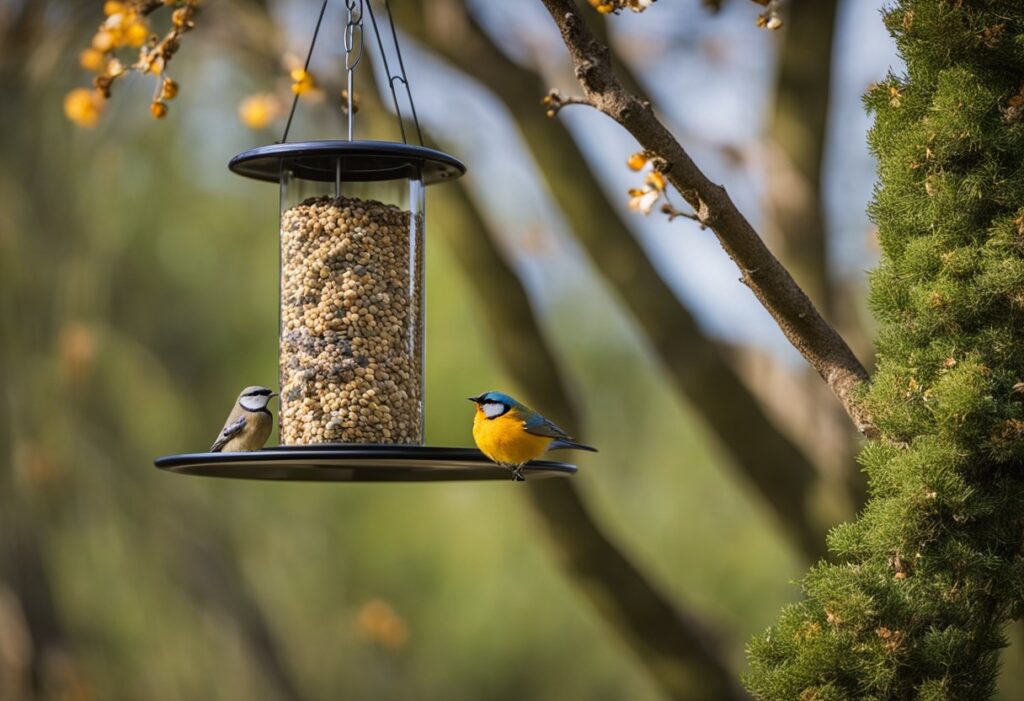
There are different types of bird feeders available on the market, and each one is designed for a specific type of bird. Choosing the right bird feeder is important as it can determine the success of your bird feeding experience. In addition to bird feeders, there are also essential bird feeding accessories that can help to keep the birds safe, healthy, and comfortable. These accessories include bird baths, bird houses, bird feed scoops, and bird feeder poles, to name a few.
Key Takeaways
- Choosing the right bird feeder and accessories is important for a successful bird feeding experience.
- Essential bird feeding accessories include bird baths, bird houses, bird feed scoops, and bird feeder poles.
- Regular maintenance and cleaning of bird feeders and accessories is necessary to keep them in good condition.
Wild Bird Feeding Accessories
| Product Name | Rating | Price |
|---|---|---|
| WUIPET Smart Bird Feeder Camera | 4.8 | $199.99 |
| Desgully Window Bird Feeder | 4.6 | $13.49 |
| Baoblaze Seed Feeder Tray | 4.6 | $13.99 |
| 2pcs Plastic Bird Feeders | 4.7 | $11.99 |
| Hanging Bird Feeder Tray | 4.5 | $9.97 |
| Sunnydaze Decorative Bird Feeder | 4.5 | $25.95 |
| iBorn Mesh Tray for Bird Feeders | 4.5 | $16.99 |
| Jarkyfine Window Bird Feeder | 4.5 | $19.98 |
| Droll Yankees Safety Wrap Hook | 4.4 | $6.99 |
| Baltimore Oriole Feeder | 4.4 | $16.99 |
| iBorn Feeders Hangers | 4.4 | $17.99 |
| Perky-Pet Seed Ball Feeder | 4.3 | $10.39 |
| HOWIRAY Automatic Bird Feeder | 4.1 | $9.99 |
| PIAOLGYI Suet Ball Holder | 3.3 | $13.99 |
| FoldTier Seed Catcher | 2.5 | $17.99 |
| Bird Feeder Hanger Hooks | 5.0 | $11.99 |
*Please note that prices are subject to change and may vary depending on the seller, location, and any applicable discounts or promotions. The ratings provided are based on customer reviews and may also change over time. Amazon Affiliate Link.
Types of Bird Feeders
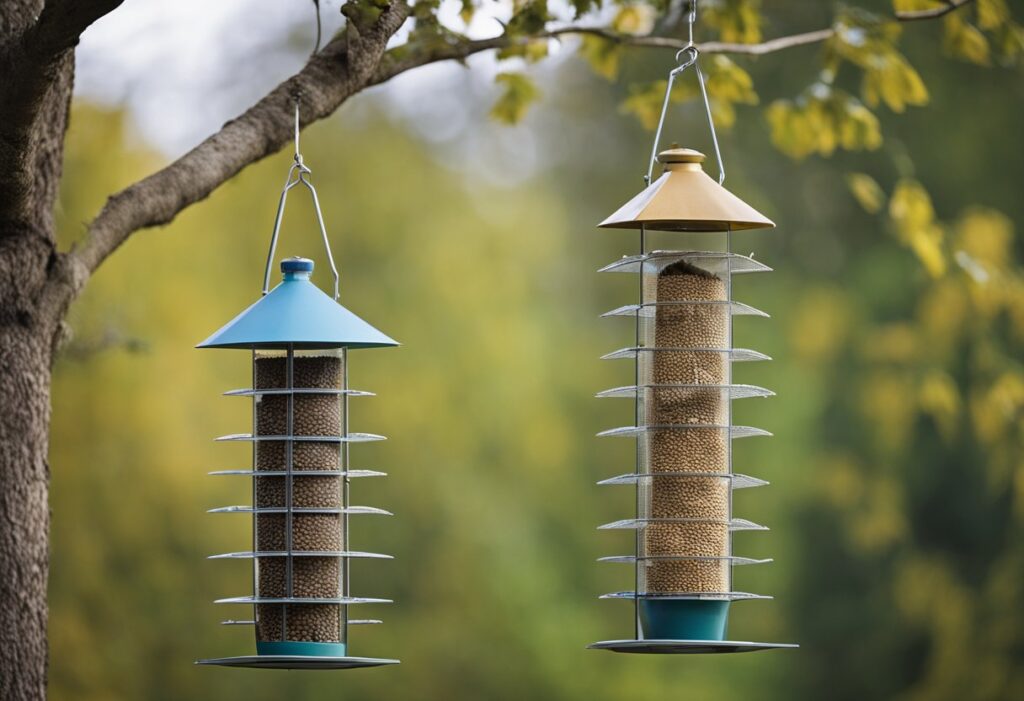
When it comes to feeding birds, there are several types of bird feeders to choose from. Each type of bird feeder is designed to attract a specific type of bird and dispense a specific type of bird feed. In this section, we will discuss the most common types of bird feeders and their features.
Hummingbird Feeders
Hummingbirds are small, colorful birds that are attracted to sweet nectar. Hummingbird feeders are designed to hold nectar and dispense it through small ports. These feeders are typically made of plastic or glass and come in a variety of shapes and sizes. Some hummingbird feeders have built-in perches, while others require hummingbirds to hover while feeding. It is important to clean hummingbird feeders regularly to prevent the growth of harmful bacteria.
Seed Feeders
Seed feeders are the most common type of bird feeder. These feeders are designed to hold a variety of bird seed, including sunflower seeds, millet, and thistle. Seed feeders come in many different shapes and sizes, including tube feeders, hopper feeders, and platform feeders. Tube feeders are long, cylindrical feeders that are ideal for small birds like finches and chickadees. Hopper feeders are larger and can hold more seed, making them ideal for larger birds like cardinals and jays. Platform feeders are flat, open feeders that can be placed on the ground or hung from a tree.
Suet Feeders
Suet feeders are designed to hold blocks of suet, a high-energy food made from animal fat. These feeders are typically made of wire mesh or plastic and can be hung from a tree or placed on a platform. Suet feeders are popular with woodpeckers, nuthatches, and other birds that cling to trees.
Overall, the type of bird feeder you choose will depend on the type of bird you want to attract and the type of bird feed you want to dispense. By choosing the right bird feeder, you can attract a wide variety of birds to your yard and provide them with the food they need to thrive.
Choosing the Right Location
When it comes to bird feeding, choosing the right location is essential. Not only do you want to attract birds, but you also want to ensure their safety and well-being. Here are some factors to consider when choosing the right location for your bird feeder.
Safety Considerations
Safety should be your top priority when selecting a location for your bird feeder. You want to make sure that the feeder is in a safe location where birds can feed without being threatened by predators or other dangers. Here are some safety considerations to keep in mind:
- Avoid placing feeders near windows: Birds can easily collide with windows, which can lead to serious injuries or death. To prevent this, place your feeder at least 30 feet away from windows, or use window decals to make the glass more visible to birds.
- Choose a location away from predators: Predators like cats, hawks, and squirrels can pose a threat to birds. To keep your feathered friends safe, place your feeder at least 10 feet away from trees or other structures that predators can climb or jump from.
- Keep the area clean: A dirty feeder can attract pests like rats and mice, which can carry diseases that can harm birds. Regularly clean your feeder and the area around it to prevent the buildup of bird droppings and other debris.
Maximizing Bird Visits
In addition to safety, you also want to choose a location that will attract a variety of bird species. Here are some tips for maximizing bird visits:
- Choose a location near wild bird habitat: Birds are more likely to visit your feeder if it is located near their natural habitat. Look for areas with trees, shrubs, and other vegetation that birds can use for cover and nesting.
- Place your feeder in a visible location: Birds are more likely to visit your feeder if they can see it from a distance. Choose a location that is visible from different angles, such as near a window or in an open area.
- Use Bird Feeding Accessories: Using bird feeding accessories like poles, baffles, and trays can help attract more birds to your feeder. For example, a baffle can help prevent squirrels from stealing birdseed, while a tray can accommodate larger birds that can’t fit on a traditional feeder.
By keeping these factors in mind, you can choose the right location for your bird feeder and attract a wide variety of birds to your yard.
Essential Bird Feeding Accessories
As bird feeding enthusiasts, we know that providing food for our feathered friends is not just a hobby but a responsibility. To make sure that our birds get the best feeding experience, we need to have the right bird feeding accessories. In this section, we will discuss the three essential bird feeding accessories that every bird feeder owner should have.
Mounting Poles
Mounting poles are essential bird feeding accessories that provide a safe and secure platform for bird feeders. They come in different sizes and are made from various materials such as metal, wood, or plastic. Some mounting poles have adjustable heights, making it easy to customize the feeding station’s height according to the type of birds you want to attract.
When choosing mounting poles, make sure that they are sturdy enough to withstand harsh weather conditions and can support the weight of your bird feeder. Also, consider the location where you will be installing the mounting pole. It should be placed in an area where birds are visible, but away from potential predators.
Squirrel Baffles
Squirrel baffles are essential bird feeding accessories that prevent squirrels and other critters from raiding your bird feeders. They come in different shapes and sizes and can be placed above or below the bird feeder. Squirrel baffles can be made from metal, plastic, or wood.
When choosing squirrel baffles, make sure that they are the appropriate size for your bird feeder. Also, consider the location where you will be installing the squirrel baffle. It should be placed in an area where squirrels and other critters cannot jump or climb onto the feeder.
Seed Trays and Scoops
Seed trays and scoops are essential bird feeding accessories that make it easy to store and dispense wild bird food. Seed trays can be attached to the bottom of the bird feeder or mounted separately. They help to catch any spilled seeds, reducing waste and mess. Seed scoops, on the other hand, are used to scoop birdseed from the bag and pour it into the feeder.
When choosing seed trays and scoops, make sure that they are compatible with your bird feeder. Also, consider the type of birdseed that you will be using. Some birdseed may require a specific type of scoop or tray.
In conclusion, having the right bird feeding accessories can make a significant difference in the bird feeding experience. Mounting poles, squirrel baffles, and seed trays and scoops are essential bird feeding accessories that every bird feeder owner should have. By choosing the right accessories, we can ensure that our feathered friends get the best feeding experience possible.
Maintaining and Cleaning
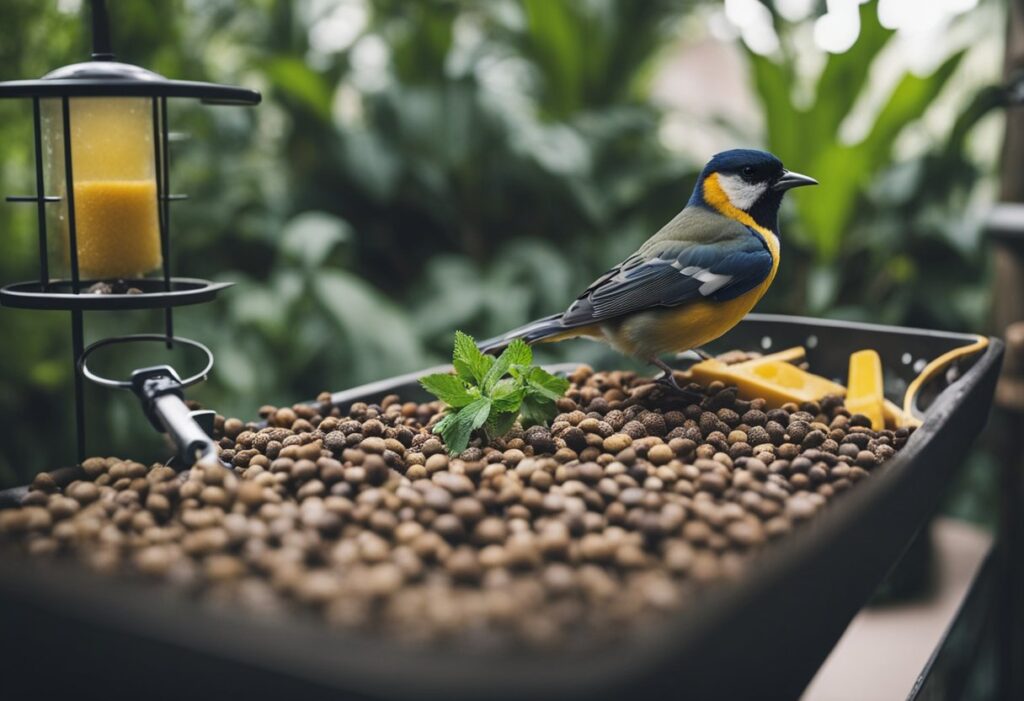
Attracting birds to your backyard can be a rewarding experience. However, it is important to maintain and clean bird feeding accessories to ensure the safety and health of the birds. In this section, we will discuss the importance of regular cleaning and preventing diseases.
Regular Cleaning
Regular cleaning of bird feeding accessories is essential to prevent the growth of bacteria and fungi that can harm birds. We recommend cleaning bird feeders, birdhouses, and birdbaths at least once a month with soap and water. For seed and suet feeders, use a mix of mild soap and water, and for sugar water feeders, add white vinegar to the mix instead. After cleaning, let the feeder dry fully before you put more food in it.
For routine cleaning of metal, acrylic, recycled plastic, or poly-lumber feeders, soap and hot water work great. For deep cleaning, use diluted bleach solution: 10 parts hot soapy water to 1 part bleach. Rinse the feeder thoroughly with clean water after using bleach.
It is important to discard any wet or moldy birdseed or other food to prevent the spread of disease. We recommend cleaning the area around the bird feeding accessories regularly to remove any spilled or leftover food.
Preventing Diseases
Birds can carry and transmit diseases to other birds through contaminated food or water. To prevent the spread of diseases, it is important to maintain a clean and dry feeding area. We recommend using a bird feeder with a tray or a ground feeder to reduce the risk of contamination.
We also recommend using products that are safe for birds. Avoid using pesticides or insecticides near bird feeding accessories as they can be harmful to birds. Instead, use natural methods to control pests, such as planting bird-friendly plants or using mesh netting to protect the food.
In summary, maintaining and cleaning bird feeding accessories is essential to ensure the safety and health of the birds. Regular cleaning with soap and water, and discarding any wet or moldy food, can prevent the growth of bacteria and fungi. Using safe products and maintaining a clean and dry feeding area can help prevent the spread of diseases.
Enhancing the Bird Feeding Experience
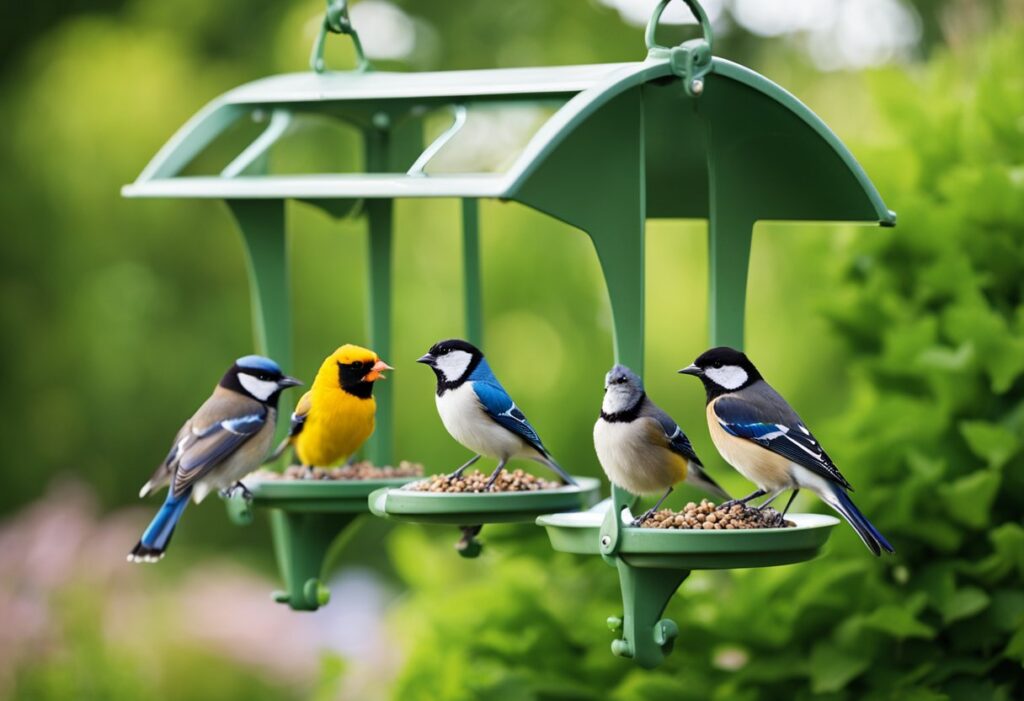
As bird enthusiasts, we know that feeding birds is not just about providing food. It’s about creating a welcoming environment that attracts diverse species and provides educational opportunities. With the right bird feeding accessories, we can enhance the bird feeding experience and make it more enjoyable for both the birds and us.
Attracting Diverse Species
One of the best ways to attract diverse bird species is by providing different types of bird feeders and bird houses. For example, tube feeders are great for small birds like finches, while hopper feeders are ideal for larger birds like cardinals and blue jays. Bird houses are also a great addition to any backyard, providing shelter for birds and encouraging them to nest.
Another way to attract diverse species is by using different types of bird food. Seed blends, suet cakes, and mealworms are just a few examples of the different types of food that can attract a variety of bird species. By offering a variety of food and feeders, we can create a diverse and welcoming environment for birds.
Educational Opportunities
Feeding birds also provides educational opportunities for us and our families. By observing birds and their behavior, we can learn more about their habits, migration patterns, and even their songs. Adding educational resources to our bird feeding area, such as bird identification charts or books, can also help us learn more about the birds we are attracting.
In addition, visiting a wild bird habitat store can provide us with even more educational opportunities. These stores often offer workshops and classes on bird feeding and bird watching, as well as a wide range of bird feeding accessories to choose from. By taking advantage of these resources, we can enhance our knowledge and appreciation of birds.
In conclusion, enhancing the bird feeding experience is about more than just providing food. By using the right bird feeding accessories, we can attract diverse species and create educational opportunities for ourselves and our families. With a little effort and the right tools, we can make our backyard a welcoming environment for birds and a great place to observe and learn from them.




